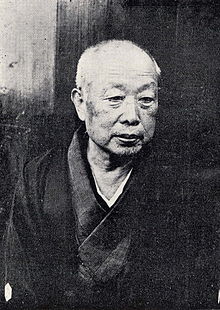Aeba Koson
Aeba Kōson ( Japanese 饗 庭 篁 村 , real name: Aeba Yosaburō ( 饗 庭 與 三郎 ), sometimes also: Takenoya Shujin ( 竹 の 屋主 人 ); * September 25, 1855 in Shitaya , Tokyo (today: Taitō ); † 20. June 1922 ) was a Japanese writer and theater critic of the Meiji period .
Life
Aeba was born as the fifth son of Yonokichi ( 與之 吉 , reading unclear) in the Shitaya district of Tokyo. Aeba's father initially ran a fabric shop in Tokyo, then a pawn shop when Aeba was born. Immediately after the birth, Aeba's mother disappeared during the Ansei Edo earthquake on November 11, 1855. During this time of need, the family received help and support from a neighboring family named Takemura, which is also where Aeba's nickname Takenoya can be traced back to.
Between the ages of 11 and 15, Aeba began an apprenticeship in Nihonbashi at the Hakone-ya pawn shop. In 1869 he returned to his parents' house and helped his older brother work in the pawn shop. At the age of 19 he began to work as a lecturer at the Yomiuri Shimbun . From 1876 onwards, Aeba was promoted by Okabatake Ransen , published first articles and soon afterwards made a name for himself in the literary world together with Okamoto Kisen and Furukawa Kairai as a gifted talent. In 1886 he met the writer Tsubouchi Shoyo know. In the same year his first long series of articles appeared Tōsei akindōkataki ( 当 世 商人 気 質 ). The first novels and adaptations of works by Edgar Allan Poe followed .
In 1889 Aeba switched to Asahi Shimbun . For the Asahi Shimbun he wrote theater reviews under the pseudonym Takenoya Shujin until 1922 . Aeba died of a brain lesion in Tokyo in 1922. Aeba is buried in the Somei cemetery in Tokyo.
Although Aeba was self-taught, he had a very good knowledge of Chinese poetry and was familiar with the poetry of Haikai . With Tsubouchi Shōyō and Kōda Rohan, Aeba is one of the writers of the transition from Gesaku to new literature.
Works
Novels
- 1886 Hito no uwasa ( 人 の 噂 )
- 1887 Sōmadō ( 走馬燈 )
- 1889 Menbokudama ( 面目 玉 )
- 1888 Horidashimono ( 掘 り 出 し 物 )
- 1889 Ryōya ( 良夜 ) published in the magazine Kokumin no tomo ( 國民 之 友 )
- Kageochi no kageochi ( 驅 落 の 驅 落 ) Text edition (PDF; Japanese; 1.1 MB)
- Haikaiki chigai ( 俳 諧 気 違 ひ )
treatise
- 1888 Ōishima tora no tsudae ( 大石 眞 虎 の 傳 ), published in the Yomiuri Shimbun (明治 21 年 読 売 新聞 発 表)
Travel reports
- 1899 Koganei no sakura ( 小 金井 の 櫻 )
Edits / translations
- Edgar Allan Poe : Seiyō kaidan kuroneko ( 西洋 怪 談 黒 猫 , Ghost Stories of the West The Black Cat )
- Edgar Allan Poe: Rumorugu no jisatsu ( ル ー モ ル グ の 人 殺 し , Eng. The double murder on Rue Morgue )
- Charles Dickens : Kagebōshi ( 影 法師 , Original: Christmas Carol )
Web links
- Aeba's works at Aozora
- Biographical summary (Japanese)
Individual evidence
- ↑ 饗 庭 篁 村 . In: デ ジ タ ル 版 日本人 名 大 辞典 + Plus /kotobank.jp. January 20, 2009, Retrieved July 25, 2011 (Japanese, online version by Nihon Jinmei Daijiten . Kodansha).
- ↑ Personal data at Aozora
- ↑ Illustration of the grave
- ↑ 国民 之 友 . In: デ ジ タ ル 版 日本人 名 大 辞典 + Plus /kotobank.jp. January 20, 2009, Retrieved July 25, 2011 (Japanese, online version by Nihon Jinmei Daijiten . Kodansha). A - for the time progressive - cultural-political magazine with articles on politics, society, economy, literature, which made socialism known.
| personal data | |
|---|---|
| SURNAME | Aeba, Koson |
| ALTERNATIVE NAMES | 饗 庭 篁 村 (Japanese); Aeba Yosaburō (real name); 饗 庭 與 三郎 (Japanese, real name); Takenoya Shujin (pseudonym); 竹 の 屋主 人 (Japanese, pseudonym) |
| BRIEF DESCRIPTION | Japanese writer and theater critic of the Meiji period |
| DATE OF BIRTH | September 25, 1855 |
| PLACE OF BIRTH | Shitaya, Tokyo |
| DATE OF DEATH | June 20, 1922 |
| Place of death | Tokyo |
